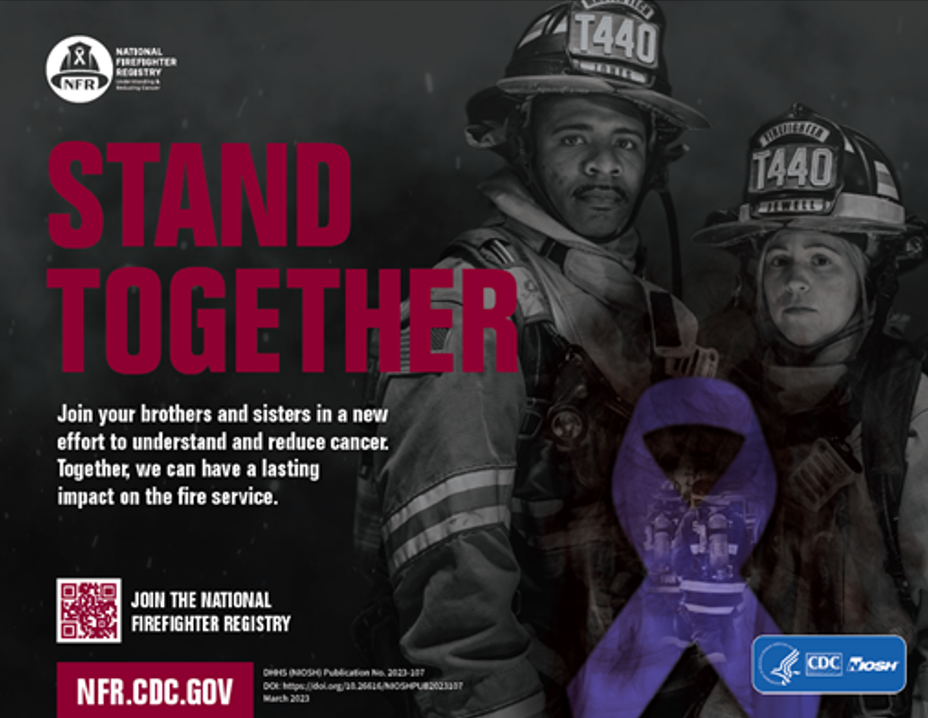The National Firefighter Registry for Cancer: Understanding the Link Between Firefighting and Cancer
Posted on by
Firefighting is a demanding profession that presents many risks from acute injuries on the fireground to long-term illness, like cancer. Firefighters can encounter cancer-causing chemicals by breathing them in, getting them on their skin or in their eyes, or by ingesting them. Exposure to these chemicals can occur while being near burning materials, from wearing turnout gear that is not properly cleaned or stored, and from residual contaminants in areas where firefighters work and live.
Research on firefighters from three large U.S. cities reported higher-than-expected rates of certain types of cancer as compared to the general U.S. population. It is important to note that past research has not included enough women or firefighters from minority racial and ethnic groups to make strong conclusions about cancer risks for all firefighters.
Firefighter Cancer Registry Act of 2018

To better understand and track on-the-job exposures to cancer-causing agents across all types of firefighters, Congress established the Firefighter Cancer Registry Act of 2018. This Act directed NIOSH to develop an online registry of firefighters. To do this, NIOSH and its partners developed the National Firefighter Registry for Cancer (NFR), which will support NIOSH researchers in studying NFR data to identify trends in
- cancer patterns
- exposures
- demographic characteristics
- protective practices
- workplace characteristics
This data will not only help to inform future interventions and best practices for the fire service to prevent cancer, but ultimately aid in understanding the relationship between firefighting and cancer.
How the NFR Works
Every time someone is diagnosed with cancer, details about their cancer are reported to the cancer registry in their state. Information about work and work exposures is not routinely included in the records shared with state cancer registries. Firefighters who provide information about themselves and their work in the fire service will allow researchers to match NFR information with cancer diagnosis information. This will help researchers to better understand cancer and its risks in the fire service. Watch this video to learn more about how the NFR works.
Join the NFR
Join at NFR.CDC.GOV
To sign up, firefighters complete the NFR survey from their phone or computer. The survey takes about 30 minutes to complete.
All U.S. firefighters, with or without cancer, no matter their length of service can join the NFR. This includes:
- active and retired firefighters
- career, paid-on-call, and volunteer firefighters
- structural firefighters
- wildland firefighters
- instructors
- fire investigators
- other fire service members
Participation in the NFR is voluntary but having many different types of firefighters join is critical to understanding cancer. The more female firefighters and those with diverse racial and ethnic backgrounds who join, the more questions we can answer about firefighting and cancer.
The NFR is a long-term project. NIOSH researchers may reach out to those who join the NFR about once a year with voluntary, but important follow-up questionnaires.
Firefighters who join the NFR, can help:
- Protect the next generation of firefighters from cancer
- Pave the way for new safety measures to protect others in the fire service
- Protect firefighter families and their communities from experiencing the impact of cancer on their loved ones
- Improve our understanding of cancer risk among groups that have been underrepresented in research, such as women, volunteers, and firefighters from some racial and ethnic groups
NFR Communication Materials
Several shareable materials – including fact sheets, posters, videos, and social media posts – are available to support firefighter enrollment in the NFR. These materials and much more are available on the NIOSH NFR page.
Will you be a trailblazer in this groundbreaking effort to understand and reduce cancer among firefighters? Will you join? Will you encourage others in the fire service to join?
Kenny Fent, PhD, CIH, is an Industrial Hygienist and Lead of the National Firefighter Registry in the Field Research Branch of the NIOSH Division of Field Studies and Engineering
Miriam R. Siegel, DrPH, MPH, is an occupational health epidemiologist in the NIOSH Division of Field Studies and Engineering
Andrea Wilkinson, MS, LAT, ATC, is a health scientist in the NIOSH Division of Field Studies and Engineering
Alexander C. Mayer, MPH, is a health scientist in the NIOSH Division of Field Studies and Engineering
Greg W. Hartle, MA, is a health communication specialist in the NIOSH Division of Field Studies and Engineering
Posted on by

